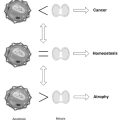Chapter 164 Erythema Multiforme
 Diagnostic Summary
Diagnostic Summary
• Sudden onset of symmetrical erythematous, edematous, macular, papular, urticarial, bullous, or purpuric skin lesions
• Evolves into “target lesions” (lesions with clear centers and concentric erythematous rings)
• Characteristic first site: dorsum of the hand
• Characteristic distribution: extensor surfaces of extremities with relative sparing of head and trunk
• Although rare, oral manifestations ranging from tender superficial erythematous and hyperkeratotic plaques to painful, deep, hemorrhagic bullae and erosions
 General Considerations
General Considerations
The term erythema multiforme (EM) includes a wide range of clinical expressions, from exclusive oral erosions (oral EM) to mucocutaneous lesions ranging from mild (EM minor) to severe involvement of multiple mucosal membranes (EM major, Stevens-Johnson syndrome [SJS]) or with involvement of a large area of the total body surface (toxic epidermal necrolysis [TEN]). However, this terminology is not accepted worldwide, and often the various clinical categories show some overlapping features. Although significant differences exist among EM minor, EM major, SJS, and TEN with regard to severity and clinical expression, all variants share two common features: typical or less typical cutaneous target lesions and satellite-cell or more widespread necrosis of the epithelium. Clinically, EM major is characterized by typical or raised atypical targets located on the extremities and/or face. SJS is diagnosed when lesions are flat, atypical targets or purpuric maculae that are widespread or distributed on the trunk.1
Among the great number of suspected etiologic factors, the differentiating feature between EM and SJS/TEN is that herpes simplex virus or mycoplasmal infections are involved in roughly 90% of cases of EM minor, whereas SJS and TEN are caused in 80% of cases by systemic drugs, mainly by anticonvulsants, sulfonamides, nonsteroidal antiinflammatory drugs, and antibiotics. However, various vaccines (e.g., Vaccinia, tuberculosis, poliomyelitis, human papillomavirus, etc.), contactants, food allergies, and other infectious organisms have all induced EM minor. Evidence clearly points to hypersensitivity and immune system–mediated tissue damage caused by the release of highly reactive, polynuclear leukocyte–derived oxygen intermediates as the common factors in all variants of EM.2
HLA-DQ3 correlates closely with recurrent EM and may be a marker to distinguish herpes-associated EM from other skin diseases.3 Biopsy can help predict disease progression from EM lesions to SJS or TEN.4
 Therapeutic Considerations
Therapeutic Considerations
Potassium Iodide
Clinical studies have documented dramatic success with potassium iodide.5–7 The mechanism is apparently related to the suppression of the generation of oxygen intermediates such as hydrogen peroxide and hydroxyl radical by stimulated neutrophils.8 Importantly, iodine therapy has occasionally been associated with various adverse skin reactions and gastrointestinal discomfort; it should never be used in pregnant women in the last trimester owing to its effect in suppressing the fetal thyroid.9,10
1. Assier H., Bastuji-Garin S., Revuz J., et al. Erythema multiforme with mucous membrane involvement and Stevens-Johnson syndrome are clinically different disorders with distinct causes. Arch Dermatol. 1995;131(5):539–543.
2. Roujeau J.C. Stevens-Johnson syndrome and toxic epidermal necrolysis are severity variants of the same disease which differs from erythema multiforme. J Dermatol. 1997;24:726–729.
3. Kämpgen E., Burg G., Wank R. Association of herpes simplex virus-induced erythema multiforme with the human leukocyte antigen DQw3. Arch Dermatol. Sep 1988;124(9):1372–1375.
4. Hosaka H., Ohtoshi S., Nakada T., et al. Erythema multiforme, Stevens-Johnson syndrome and toxic epidermal necrolysis: frozen-section diagnosis. J Dermatol. 2010 May;37(5):407–412.
5. Horio T., Danno K., Okamoto H., et al. Potassium iodide in erythema nodosum and other erythematous dermatoses. J Am Acad Dermatol. 1983;9:77–81.
6. Schultz E.J., Whiting D.A. Treatment of erythema nodosum and nodular vasculitis with potassium iodide. Br J Dermatol. 1976;94:75–78.
7. Kelly F. Iodine in medicine and pharmacy since its discovery: 1811-1961. Proc R Soc Med. 1961;54:831–836.
8. Miyachi Y., Niwa Y. Effects of potassium iodide, colchicine, and dapsone on the generation of PMN derived oxygen intermediates. Br J Dermatol. 1982;107:209–214.
9. Zone J.J. Potassium iodide and vasculitis. Arch Dermatol. 1981;117:758–759.
10. Sterling J.B., Heymann W.R. Potassium iodide in dermatology: a 19th century drug for the 21st century-uses, pharmacology, adverse effects, and contraindications. J Am Acad Dermatol. 2000 Oct;43(4):691–697.
11. Brody I. Topical treatment of recurrent herpes simplex and post-herpetic erythema multiforme with low concentrations of zinc sulphate solution. Br J Dermatol. 1981;104:191–194.


